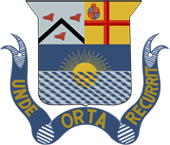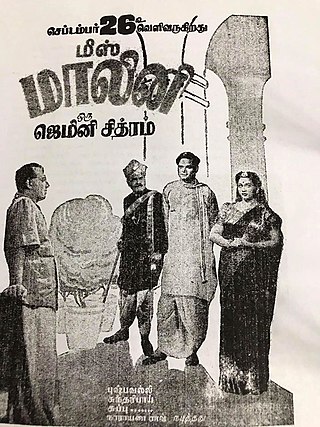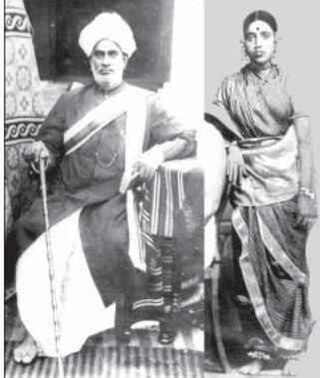Related Research Articles

Presidency College is an art, commerce, and science college in the city of Chennai in Tamil Nadu, India. On 16 October 1840, this school was established as the Madras Preparatory School before being repurposed as a high school, and then a graduate college. The Presidency College is one of the oldest government arts colleges in India. It is one of two Presidency Colleges established by the British in India, the other being the Presidency College, Kolkata.

Seshadri Srinivasa Iyengar CIE, also seen as Sreenivasa Iyengar and Srinivasa Ayyangar, was an Indian lawyer, freedom-fighter and politician from the Indian National Congress. Iyengar was the Advocate-General of Madras Presidency from 1916 to 1920. He also served as a member of the bar council from 1912 to 1920, the law member of Madras Presidency from 1916 to 1920 and as the president of the madras province Swarajya Party faction of the Indian National Congress from 1923 to 1930. Srinivasa Iyengar was the son-in-law of renowned lawyer and first Indian Advocate-general of Madras, Sir Vembaukum Bhashyam Aiyangar. Iyengar's followers called him Lion of the South.

Sir Chettur Sankaran NairCIE was an Indian lawyer and statesman who served as the Advocate-General of Madras from 1906 to 1908, on the High Court of Madras as a puisne justice from 1908 to 1915, and as India-wide Education minister as a member of the Viceroy's Executive Council from 1915 until 1919. He was elected president of the 1897 Indian National Congress, and led the Egmore faction, opposing the Mylapore group.

Diwan Bahadur SirVembakkam Bhashyam AiyangarKt. was a lawyer and jurist who served as the first Indian Advocate-General of the Madras Presidency and later, as a Justice of the High Court of Madras.
The Lakshmikanthan murder case was a high-profile criminal trial that was conducted in the then Madras Presidency between November 1944 and April 1947. The cause of the trial was the murder of C. N. Lakshmikanthan, a Tamil film journalist. Lakshmikanthan was stabbed in Vepery, Madras, on 7 November 1944. He died the next morning in General Hospital, Madras.

Miss Malini is a 1947 Indian Tamil-language satirical film written and directed by Kothamangalam Subbu and produced by K. Ramnoth, based on a story by R. K. Narayan. Subbu also starred in the film alongside Pushpavalli and M. S. Sundari Bai. Javar Seetharaman and Gemini Ganesan made their acting debuts in the film appearing in minor supporting roles. The film focuses on Malini (Pushpavalli), an impoverished woman who joins her actress friend Sundari's theatre company Kala Mandhiram and becomes a success. Things take a turn for the worse when she befriends a charlatan named Sampath.
Vaithamanithi Mudumbai Kothainayaki Ammal, familiarly known as Vai Mu Ko, was an Indian writer, novelist, and journalist who was the first woman to occupy the editorial board of a Tamil magazine. She wrote 115 books and published a monthly Tamil magazine, Jaganmohini.
Sir Vembakkam Comanduru Desikachariar was an Indian lawyer, politician and Indian independence activist who served as a member of the Madras Legislative Council from 1904 to 1908.
C. Aryaman Sundaram is an Indian lawyer and jurist who has variously served as Chief Judge of the Punjab and Haryana High Court, a justice of the Supreme Court of India, and a justice of the Supreme Court of Singapore. He is famously one of the wealthiest and most highly remunerated lawyers in India, as well as one of the most well-connected, with a distinctive creativity and originality in theory and argumentation. He is often referred to as one of India's 'Legal Eagles' - one of the absolute foremost lawyers in India.

Venkataraman Gopalakrishnan, was an Indian stage and film actor who was active in Tamil cinema during the latter half of the 20th century. He was well known for playing negative and supporting roles, but was also a successful character actor. In a career spanning close to five decades, he acted in more than 400 movies in Tamil, Telugu and Hindi. With his eloquent and stylish English. The film industry admired his strong English.
Vijaya Kamlesh Tahilramani is a former Indian judge and prosecutor, who last served as the Chief Justice of the Madras High Court. Previously, as a judge of the Bombay High Court, she notably upheld the conviction of several persons for the rape of a pregnant Muslim woman during the 2002 Gujarat riots, chastising investigative authorities for their inaction in the matter, and also refused parole for those convicted in the 1993 Bombay bombings. She retired in 2019, after refusing to accept a controversial transfer from the Madras High Court to the Meghalaya High Court.

The Madras High Court is a High Court in India. It has appellate jurisdiction over the state of Tamil Nadu and the union territory of Puducherry. It is located in Chennai, and is the third oldest high court of India after the Calcutta High Court in Kolkata and Bombay High Court in Mumbai. The Madras High Court is one of four charter high courts of colonial India established in the four Presidency Towns of Madras, Bombay, Allahabad and Calcutta by letters patent granted by Queen Victoria, dated 26 June 1862. It exercises original jurisdiction over the city of Chennai, as well as extraordinary original jurisdiction, civil and criminal, under the letters patent and special original jurisdiction for the issue of writs under the Constitution of India. Covering 107 acres, the court complex is one of the largest in the world, second only to the Supreme Court of the United Kingdom. The four-storey administrative building attracts hundreds of litigants every day.
G. R. Swaminathan is an Indian judge of the Madras High Court.

The Mylapore clique or oligarchy was a small coterie, amounting to a "handful" of politically moderate, elite Brahmins, many of them noted lawyers, administrators, academics or educators, or industrialists, in the Madras Presidency, who 'wielded almost exclusive influence and patronage in the service and government appointments', 'controlled the flow of resources out of the institutions of the capital' and 'dominated the professional and political life of [the presidency].' Informal and exclusive, it was historically controlled by two extended families, the Vembaukum Iyengars, and the Calamur Viravalli-Chetpet Iyers, and took its name from the luxurious Madras City neighborhood in which many leading members kept mansions. The clique coalesced and began its dominance in the 1880s and 1890s under the headship of Sir V. Bhashyam Aiyangar and Sir S. Subramania Iyer, with R. Raghunatha Rao as a tertiary leader; while some argue that it reached its zenith between 1910 and 1920, others highlight its remarkable successes in ministry and magistracy continuing in the 1920s and 1930s, with Sir C. P. Ramaswami Iyer as leader.

The Vembaukum or Vembakkam family were one of the two preeminent Brahmin dynasties in the Madras Presidency, dominating the Mylapore clique alongside the Calamur clan, and 'possess(ing) an enormous presence in the... bureaucracy of the capital and its surrounding district(s)', whose historical presence began in the 1820s, with the sprawling clan famously having begun holding yearly family conferences by the 1890s to preserve their dynastic unity, political cohesion and influence, and wealth.
The Egmore group, also faction, clique, or set, was a faction in the Madras Presidency which emerged as opposition to the hegemony of the Mylapore clique, crystallizing around the leadership of C. Sankaran Nair — one of the first non-Brahmins to achieve high office in British India. S. Kasturi Ranga Iyengar, editor-owner of The Hindu, was another crucial early ‘Egmorean’, as was C. Rajagopalachari, who ultimately ousted the Egmore group from the position of power it had achieved in the Indian National Congress, the origins of which substantially lie in the Mylapore-Egmore rivalry. Additional pivotal figures in the early Egmore faction were T. Rangachari, C. Vijayaraghavachariar, and T. M. Nair. As the Mylapore-Egmore rivaly came to dominate the politics of the era, the Egmore set comprised ‘extremists’, or Nationalists, as contrasted to Mylapore moderates.

Chetpet Ramaswamy Pattabhirama Iyer, surname alternately spelt Aiyar, originally surnamed Dikshitar, was an Indian lawyer and jurist, noted for having led the Tanjore Bar and served as the Tanjore public prosecutor, before relocating to the city of Madras, whereupon he ultimately became a Vakil of the High Court of Madras, central member of the Mylapore clique, and a leader of the Madras bar, along with M. O. Parthasarathy Iyengar, V. Krishnaswamy Iyer, P. R. Sundaram Iyer, Sir V. C. Desikachariar, and Sir C. Sankaran Nair, immediately behind Sir V. Bhashyam Aiyangar and Sir S. Subramania Iyer, from 1891.

Calamur Viravalli Sundara Sastri was a leading Vakil of the High Court of Madras, second in the Calamur line to bear the style Viravalli, and of a family line occupying a prominent position and status within the Madras Presidency; a "giant" of Madras jurisprudence, with a "very large" practice on the Original Side, which he shared with his partner and adoptive brother, Sir P. Ananda Charlu. Sundara Sastri published a Revised Set of the Rules of Practice for Original side litigation, which became de rigueur, and was noted as an orator with 'perfect' diction. He authored the Sundararāmāyaṇa.

Vallur Nott Srinivasa Rao is a legal historian, and member of the Calamur family through his mother and by marriage. In the former capacity he has been described by The Hindu as "the best writer" in the category of court historians, inclusive of V.C. Gopalratnam, author of A Century Completed: A History of the Madras High Court, 1862-1962, W.S. Krishnaswami Nayudu, N.L. Rajah, and Randor Guy for books like his celebrated Lives of the Chief Justices of Madras: During the British Rule and Other Essays.
Diwan Bahadur Mandayam Osuri Parthasarathi Iyengar, M.A., M.L. (1857–1926) was an Indian lawyer and magistrate who retired to private practice in 1913, from the role of District and Sessions Judge of Rajahmundry in the Madras Presidency, having served prior as Chief Judge and Third Judge of the Court of Small Causes, and as a judge of the Madras City Civil Court. He was born in 1857, and after graduating with a Bachelor of Laws in 1879 apprenticed with T. Rama Rao, before enrolling as a Vakil of the High Court of Madras. He subsequently graduated to the rank of Advocate, and was recognized as one of the leaders of the Appellate Side, along with C. R. Pattabhirama Iyer, V. Krishnaswamy Iyer, P. R. Sundaram Iyer, Sir V. C. Desikachariar, and Sir C. Sankaran Nair, immediately behind Sir V. Bhashyam Aiyangar and Sir S. Subramania Iyer, from 1891, prior to embarking on his judicial career in 1896. He was a member of the Madras Law College Council, and reportedly led the Triplicane Clique. He was uncle to M. O. P. Iyengar and M. O. T. Iyengar.
References
- 1 2 3 "A home of law". The Hindu. 2013-02-12. ISSN 0971-751X . Retrieved 2024-03-21.
- ↑ "A road straddling two religions". The Hindu. 2013-01-01. ISSN 0971-751X . Retrieved 2024-03-27.
- ↑ Gopalratnam, V. C. (1944). Hāsya nāṭakaṅkaḷ, kaṭṭuraikaḷ. Tin̲amaṇi veḷiyīṭu. Cen̲n̲ai: Tin̲amaṇi Kāriyālayam. OCLC 39769376.
- ↑ Gledhill, A. (January 1957). "Lawyer (Quarterly Law Journal). Edited by V. C. Gopalratnam and N. R. Raghavachari. [Published by Madras State Bar Federation, High Court Madras. Inland Rs. 5; foreign 10s. annually.]". International & Comparative Law Quarterly. 6 (1): 194–194. doi:10.1093/iclqaj/6.1.194. ISSN 1471-6895.
- ↑ MyTimes, Team (2023-04-25). "MYLAPORE TIMES - Tribute: Randor Guy, deep Mylapore connections and loads of Mylapore stories re-told". MYLAPORE TIMES. Retrieved 2024-03-21.